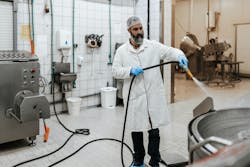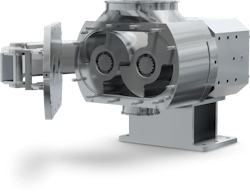How pump technology is addressing the worker shortage in food processing
There is a perfect storm of causes contributing to the labor shortage in the process manufacturing industries. According to a recent study focusing on the meat, poultry, seafood and alternative proteins industries, the Packaging Machinery Manufacturers Institute (PMMI) reports that labor is the biggest operational challenge for nearly two-thirds of respondents. This follows a 2022 PMMI report that identified the scarcity of workers as the most immediate challenge for the food processing industry broadly. Attracting and retaining qualified workers is a top challenge for the food processing industry.
Surviving the storm
Before considering possible solutions to the labor shortage, it may be useful to understand the causes. Some people left the workforce during the COVID-19 pandemic, and many workers are retiring. Unlike the former generations, younger workers perceive manufacturing jobs to be unappealing. Often, food processing facilities are located close to their agricultural suppliers and in rural areas, where the pool of qualified workers may be limited.
When managers succeed in recruiting new workers, retaining them is the next challenge. A study from the Bureau of Labor Statistics indicates that the turnover rate in manufacturing jobs was 39% in 2023. Employees with childcare, health and transportation constraints can experience scheduling challenges that make it difficult to maintain consistent availability. Alternatively, for plant workers with long commutes, rising gas prices make their jobs less rewarding.
Food processors compete with other comparable companies for available talent. Faced with the shortage of skilled maintenance staff due to retirements and high turnover rates, plant operators are urgently seeking solutions. Fortunately, advances in technology are emerging to help operators address these issues.
Unsung heroes: sanitation crews
Staffing struggles are especially evident for the managers who must find workers to clean and sanitize process equipment on the third shift. The work is not easy. The workplace is uncomfortably damp and filled with the pungent smell of cleaning solutions and food odors. Further, sanitation teams must work quickly to sanitize the whole plant before the next shift. The work of these unsung heroes is critical to safeguarding production and avoiding product recalls. Yet, it is not easy to keep these positions staffed and the individuals trained.
Because of the critical need to meet sanitation requirements, crews spend hours cleaning the hygienic pumps rooted in the heart of many processing applications — especially pumps that transfer raw ground meat, yogurt, nut butter and other viscous foods. Clean-in-place systems may not adequately clean pumps for viscous products, so crews disassemble and clean the pumps manually. Manual cleaning is also common for pumps that transfer low-viscosity foods such as raw egg whites where cleanliness is paramount. This constant cleaning regimen introduces the risk of pump damage, foreign object contamination and worker injury. Even so, managers are most concerned with finding and retaining the labor devoted to cleaning and maintaining pumps.
Modern pump design is helping maintenance managers stretch scarce labor resources by decreasing the time crews must spend cleaning and maintaining pumps. It may also help managers retain their unsung heroes by making the process of cleaning the pump easier. Pump design also positively impacts sanitation quality and maintenance costs as pump technology evolves to meet these challenges.
Labor-saving pump technology
Recent advancements in pump technology have emerged to tackle the labor challenges of pump users. Some hygienic lobe pumps specifically designed for fast disassembly and reassembly are now available, significantly shortening cleaning time. To understand the impact, let’s explore these innovative lobe pump features and how they minimize labor requirements.
- Traditional pumps often have many parts making disassembly and cleaning a time-consuming process that requires skilled technicians. Newer pumps address this challenge with a simplified design. Nearly every pump manufacturer is redesigning their pumps to have fewer parts, resulting in faster disassembly and reassembly, freeing up valuable time for maintenance staff to focus on other critical tasks.
- The smallest parts of a pump, such as rotors bolts, screws, studs and pins, are difficult to handle and easy to lose track of. Pump designs that have fewer small parts make it easier for cleaning crews to do their jobs, saving them time.
- Innovative pump components are designed for one-way assembly. The design simplifies new worker training, which may be time-consuming for supervisors with high worker turnover.
- Pumps with hinged swing-arm covers simplify cleaning because the cover stays out of the way while remaining connected to the pump rather than being placed on the dirty floor during cleaning. Workers save time when the pump is easier to clean.
- Some pumps are designed for tool-free assembly. Cleaning crews can work faster and safer and reduce the risk of pump damage because no tools are needed.
The emergence of lobe pumps with these features allows for quicker and easier cleaning, which can be performed by less skilled workers without compromising sanitation. Typically, a worker can clean a pump with a modern design in 15 minutes, compared to the hour usually required for earlier pump designs. The 45 minutes saved can then be reallocated to other tasks. Instead of spending an hour on one task, a crew member may complete three tasks within that hour. These time savings accumulate quickly in facilities with multiple pumps, resulting in significant hours saved annually.
The desire to save labor hours is also driving design changes to air-operated double-diaphragm (AODD) pumps. These pumps are ubiquitous in food production owing to their reliable design, versatility and ability to pump viscous liquids.
In the center of a traditional AODD pump, compressed air drives diaphragms that move the process fluid through the pipework on each side of the pump. Conversely, an available innovative AODD design routes the compressed air outside the diaphragms and pumps the fluid though the middle. This pump style eliminates the need for the bulkier system. As a result, the pump is easily accessible for cleaning and maintenance.
This pump option can be disassembled by removing only one large nut, with no need to disassemble any pipework. The impact on labor hours is significant. While a traditional AODD pump may take up to an hour to clean, the innovative design makes it possible for workers to clean the pump in only 15 minutes. In the same way, routine maintenance, such as diaphragm and seal replacements, is greatly accelerated.
The impact of evolving pump design on cost
Of course, advances in pump technology are not limited to addressing labor issues. Many design improvements avoid potential costs and reduce maintenance. Limiting these expenses stretches the overall budget, which can give managers flexibility in wages. This flexibility is critical given that manufacturing wages in the United States are climbing steeply. According to YCharts.com, the hourly wage for production and nonsupervisory workers has climbed 27% since the start of 2020.
When one looks at recent advances in pump technology that are helping manufacturers avoid costs, several features stand out:
- Pumps with fewer small parts reduce the risk of pump damage. Third-shift workers may feel rushed to move to the next task. As a result, many pumps have been returned to service without a seal or screw, often with serious consequences for the pump. Further, having fewer small parts means less chance of them becoming dislodged and contaminating the process stream, which could trigger a costly recall.
- Pump components designed for one-way assembly eliminate the risk of a part being installed backward, which could lead to expensive pump damage.
- When no tools are needed for maintenance or assembly, there is less chance of workers scratching the interior of the pump. Scratches can harbor bacteria, so it is imperative to protect the hygienic design of the interior surface. No operator wants to be the cause of contamination and the resulting fines and lawsuits.
- Eliminating the need for rotor bolts eliminates a potential point of failure. Sometimes rotor bolts loosen and can cause catastrophic damage to the pump. The bolts, or fragments of them, may even end up in the product.
- The cover on lobe pumps is heavy and often slippery with product and cleaning agents. Cleaning crews could drop the cover and injure themselves. In addition to covering medical expenses, the manager must find a temporary replacement for the injured worker. A pump with a hinged cover eliminates any potential for dropping.
Conclusion
The ongoing shortage of skilled workers in the food processing industry underscores the need for easily serviceable and reliable equipment. Evolving pump technology offers a viable solution by simplifying maintenance processes, improving sanitation and optimizing labor use. As the food processing industry evolves, embracing these advancements will be crucial for maintaining productivity and ensuring food safety.
About the Author
Olivia Kight
Applications engineer with Unibloc Hygienic Technologies
Olivia Kight is an applications engineer with Unibloc Hygienic Technologies. She loves applying engineering problem-solving to customer problems in the processing industries. She holds a Master of Engineering (mechanical) from Mercer University.

